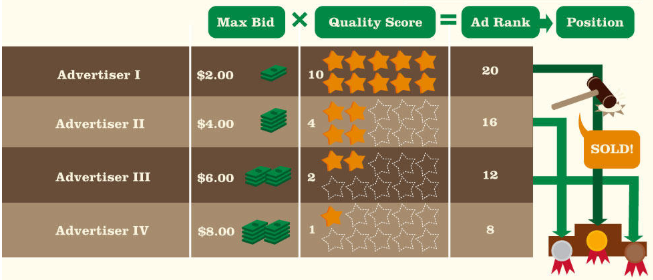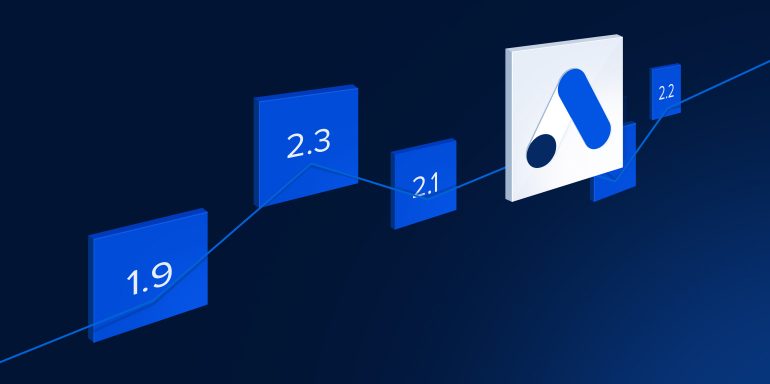Forget everything you know about the Google Ads average position metric because the search engine is scrapping the metric.
Starting in September 2019, your Google Ads will be ranked using a group of new metrics (more on this later). But what does this mean for you and more importantly, why should you care?
In this article, you’ll discover what is changing inside Google Ads and how the changes will affect the average position metric and how you manage ads going forward.
First, let’s review why the death of the average position metric is a big deal, and why it’s not all bad news for paid advertising managers and agencies who manage Google Ad campaigns.
Average position: Why is it important?
The average position in Google Ads was once a vital metric the platform used to determine where paid ads would show in SERPs. The calculations behind it all were a little more complicated.
First, Google factored your ad rank (a mix of your ad’s quality score and your maximum CPM) based on a formula:

Once it knew a bit about your ad scores, Google then determined what position to show your ad. This is how Google ensured the best ads were shown to search users, and not just the ads that were backed with the biggest ad spend:

Because of these metrics, it has always been mandatory to have quality ads, post-click landing pages, and keywords that maintained a decent average position for your campaigns.
However, just because your ad has an average position of “2” doesn’t always mean it shows up in the 2nd spot (after all, it’s just an average). For that reason, Google decided it’s not the best metric to measure ads.
Why you should care about average position being removed
Digital marketing is constantly changing and what worked one day, may not work the next. But Google Ads average position metric has been a constant for PPC marketers since paid search ads began.
Now that it’s being ditched, you will have to change the way you evaluate an ad’s position in the Google SERP. From your bidding strategies to implementing the new position metrics, the way you measure your campaigns is about to change.
What’s changing, and what metrics will replace average position?
When Google Ads announced it was being removed, the platform also said it would be replaced with new metrics. The new metrics have been labeled top and absolute top metrics, and ads will be measured by their auction performance alongside their SERP visibility when the average position is phased out.
What does that mean for you? Instead of only worrying about your ad rank, you also need to focus on your ads’ impression share.
Although the new metrics may seem complicated, they’re not. The new metrics tell you how often your ad is at the top of a page, and what share of all the top of page impressions they’re getting. Here’s a breakdown of the new metrics.
Top impression rate
Shown as a percentage, this metric will be calculated by the total number of impressions you receive from the top of Google’s SERP results:

Absolute top impression rate
Similar to the top impression rate, your absolute top impression rate calculates your ad’s total impressions (but only by those received from the absolute top of the SERP):


Top impression share
This metric details the impressions you’ve received anywhere above organic search results compared to the estimated number of impressions you were eligible to receive in the top location:

Absolute top impression share
Absolute top impression share calculates the number of impressions you received at the very top ad position in a Google SERP divided by the estimated number of impressions you were eligible to receive in the top spot.

Pro Tip: Google recommends advertisers don’t use these metrics as a target to set bids. In their own words, “sometimes, the metrics may decrease as bids increase.” Instead, they recommend advertisers maintain a higher bid as it will provide them a more competitive edge when an auction is in a worse location.
Why is the change happening?
Over time the average position metric has become less valuable for performance measures and Google’s new metrics can tell you a lot more about how a campaign is performing.
Instead of your ad being calculated on rankings and quality scores, Google shifted the focus to the user and will now hone in on their search intent. The overall relevance and impression of your ads are the only ways to win with the metric changes.
Google Ads has been slowly moving towards a more automated structure, so it makes sense that signals, context, and intent will now be used as ranking factors for ad positioning.
Three ways to take advantage of the change
Now is the time to start preparing for the changes. Here are three ways you can brave the storm:
1. Start mastering the new metrics now
Why wait until average position is gone?
Start by playing around with the performance of each of the different metrics. See what performs better on different devices, and get a feel how you can use the new metrics in your campaigns. That way, when average position is officially replaced by the new metrics, you won’t be playing catch up.
2. Focus on your audience
We know the decision to scrap average position for top and absolute top metrics was to enhance the searcher’s experience.
But how can you win with the new metrics? Simple — match your ads to search intent.
Look at your campaigns and identify what searchers are really trying to find, before, during, and after they get to your website. The more you know about your different audience types and their behaviors, the easier it will be to make informed decisions about your paid ad strategies.
3. Trust Google’s suggested automated strategies
In your Google Ads dashboard campaign settings, you can already see the new metrics in play. If you’re not sure how to begin using them without spending your entire campaign budget, start by trusting Google’s suggestions.
For example, you can choose to focus your campaign on impression share and have it land at the absolute top of the SERPs:

The campaign will then focus on a target impression share bid strategy, and you can automate top of page targeting, too.
The sooner you understand the new metrics, the more comfortable you’ll be adjusting your reports when the changes take full effect. Start by slowly changing out your position metrics for the new metrics, and you can start to phase out average position in your campaign before Google removes it completely.
How advertisers can benefit from the new metrics
As an advertiser, the decision to replace average position will impact how you create search ads. If your campaigns stretch beyond YouTube display advertising and search partners, and you want to be featured in the SERPs, you’ll need to modify your strategy for the new metrics.
Previously, even if your average position were good, if your ad didn’t pass all of the other criteria set by Google like Quality Score, it wouldn’t be shown at the top of the page. Now, you can choose to bid at the absolute top of the page.
Sunsetting average position is a new horizon for PPC
If you manage PPC ads, you already know that the way you build and analyze campaigns changes constantly. It’s just part of the industry.
But the impending removal of average position has come as a shock to a lot of PPC experts in the industry, mainly because it was one of the few metrics that Google Ads started with:

It’s not all bad news, though. The new metrics provide advertisers an opportunity to benefit more from search intent, not just Quality Score and max CPM.
One thing is for sure, Google Ads automation is getting smarter and there is less of a need for manual bidding strategies. The new metrics give advertisers the tools to make these complicated bidding decisions with an automated helping hand.
Overall, the new metrics aim to make it easier for advertisers to adjust their bidding to show for the top ad slot in Google. Only time will tell, though, if phasing out average position was the right move.
Getting the most out of your advertising campaigns goes far beyond the new Google metrics. For tips on how to optimize your digital advertising, download the Reference Guide for All Digital Advertising Formats.
